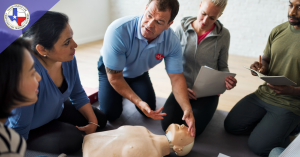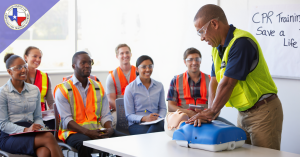OSHA Compliant CPR Training in Texas Enhances Emergency Readiness
OSHA-compliant CPR training in Texas equips employees to handle workplace emergencies, ensuring safety, compliance, and preparedness across industries.
DALLAS, TX, UNITED STATES, October 13, 2025 /EINPresswire.com/ -- OSHA-compliant CPR training in Texas is helping businesses strengthen workplace safety and emergency preparedness while ensuring compliance with federal safety standards.Texas - Organizations across Texas are increasingly prioritizing emergency preparedness through OSHA-compliant CPR training. By meeting Occupational Safety and Health Administration (OSHA) standards, businesses and institutions ensure their employees are better equipped to respond to sudden medical emergencies in the workplace. This proactive approach not only safeguards employees but also fosters compliance with regulatory requirements that protect workplace safety.
Importance of OSHA Compliant CPR Training
OSHA requires that employers provide a safe working environment, and part of that responsibility involves ensuring that workers are trained in life-saving skills when hazards exist. OSHA-compliant CPR training in Texas plays a crucial role in meeting this mandate. Workplaces ranging from construction sites to corporate offices face potential emergencies such as cardiac arrest, choking, or respiratory failure. Quick, informed intervention by trained personnel can mean the difference between life and death.
While CPR training is widely available, OSHA compliance ensures that the training provided follows specific guidelines aligned with federal safety standards. This compliance guarantees that the instruction is thorough, up to date with medical protocols, and tailored to workplace needs.
Who Benefits From OSHA Compliant Training
Businesses in high-risk sectors, such as construction, manufacturing, oil and gas, and healthcare, must meet OSHA standards for employee safety training. However, organizations in retail, education, hospitality, and office environments also benefit from preparing staff to respond effectively to emergencies.
Employees trained through OSHA-compliant CPR courses learn:
How to recognize the signs of cardiac arrest and respiratory distress.
Techniques for performing high-quality chest compressions and rescue breathing.
Proper use of automated external defibrillators (AEDs).
How to handle airway obstructions.
Workplace-specific response protocols.
This knowledge equips employees to act immediately, reducing the likelihood of severe outcomes before professional medical help arrives.
Workplace Readiness and Compliance
OSHA standards emphasize preparedness in environments where occupational hazards exist. In Texas, employers who implement OSHA-compliant CPR training demonstrate a commitment to both workplace safety and legal responsibility. Noncompliance with safety regulations can result in penalties, legal liability, and reputational damage.
By aligning with OSHA guidelines, companies create a safer environment and reinforce their safety culture. Training programs are often customized to meet the needs of specific industries, ensuring relevance for employees while fulfilling regulatory obligations.
Structure of OSHA Compliant CPR Programs
OSHA-compliant CPR training in Texas is structured to ensure participants receive hands-on, practical education alongside theoretical instruction. Courses typically include:
Interactive Instruction: Participants learn step-by-step CPR procedures from certified trainers.
Hands-On Practice: Use of CPR manikins and AED training devices allows learners to practice in real-life scenarios.
Workplace Relevance: Content is adapted to address hazards specific to each industry or job site.
Assessment and Certification: Successful participants receive certification valid for a specified period, confirming compliance with OSHA standards.
These structured programs ensure employees not only acquire knowledge but also gain confidence in applying it effectively during emergencies.
Expanding Access Across Texas
Demand for OSHA-compliant CPR training is growing statewide, from urban centers like Houston, Dallas, and San Antonio to smaller communities. Employers recognize that training should be accessible and delivered on-site to minimize disruptions to operations. Onsite training solutions allow organizations to train multiple employees at once while tailoring the instruction to specific workplace conditions.
Additionally, online and blended learning formats are becoming more common. These models combine self-paced digital modules with in-person practice sessions, offering flexibility while maintaining OSHA compliance.
Emergency Response Beyond CPR
While CPR remains a central component, OSHA-compliant training programs often extend to other emergency response areas. In Texas, many employers incorporate:
First Aid Training: Covering wound care, burns, fractures, and common workplace injuries.
Bloodborne Pathogen Training: Essential for employees who may be exposed to blood or other potentially infectious materials.
AED Usage: Instruction on how to safely use defibrillators during cardiac emergencies.
Respiratory and Choking Response: Techniques for handling airway obstructions and breathing emergencies.
By offering comprehensive training, organizations provide employees with the skills to handle a wide range of medical emergencies until professional responders arrive.
OSHA Standards and Legal Considerations
OSHA does not explicitly mandate CPR training for every workplace, but requires it in industries with identified risks. For example, construction and confined space worksites may necessitate CPR and first aid training due to the likelihood of medical emergencies.
Employers must ensure training meets the American Heart Association (AHA) or Red Cross standards to satisfy OSHA requirements. Documentation of employee training is also necessary in case of audits or inspections.
Through proper training, companies can demonstrate compliance, reduce liability, and strengthen employee safety awareness.
Growing Need in Texas Workplaces
Texas's diverse industries, from energy production to agriculture, face unique safety challenges. The presence of high-risk job sites makes OSHA-compliant CPR training especially relevant. Workers often operate in remote locations where immediate medical help may not be available, making trained responders essential.
Even in urban office settings, cardiac emergencies remain a possibility. According to health data, sudden cardiac arrest is a leading cause of workplace fatalities nationwide. Prompt CPR and AED use can double or triple survival rates, underscoring the need for widespread employee readiness.
Long-Term Value for Organizations
OSHA-compliant CPR training is more than a regulatory measure; it is an investment in organizational resilience. Employees trained to respond to emergencies contribute to:
Reduced downtime in the event of medical incidents.
Increased employee confidence and morale.
Strengthened workplace safety culture.
Lower risk of OSHA penalties and legal claims.
By integrating CPR training into broader workplace safety programs, Texas businesses foster preparedness that benefits both employees and employers.
About Texas OnSite CPR
Texas OnSite CPR is a professional training provider specializing in OSHA-compliant CPR, First Aid, AED, and workplace safety programs. Serving businesses, schools, healthcare providers, and community organizations across Texas, the company delivers training tailored to meet OSHA and industry-specific requirements. With a focus on accessibility and compliance, Texas OnSite CPR provides both onsite and blended training solutions to ensure participants are prepared for emergencies.
Thomas McMillan
Texas Onsite CPR
+1 817-992-0585
cprtom@mac.com
Legal Disclaimer:
EIN Presswire provides this news content "as is" without warranty of any kind. We do not accept any responsibility or liability for the accuracy, content, images, videos, licenses, completeness, legality, or reliability of the information contained in this article. If you have any complaints or copyright issues related to this article, kindly contact the author above.




